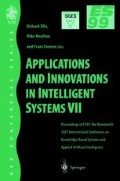Abstract
In this paper we present an initial overview of SHAMASH, a process modeling tool for Business Process Reengineering. The main features that differentiate it from most current related tools are its ability to define and use organisation standards, and make automatic model simulation and optimisation of them. SHAMASH is a knowledge based system, and we include a discussion on how knowledge acquisition it should be possible, furthemore we introduce a high level description of architecture and other importants modules of the system.
Access this chapter
Tax calculation will be finalised at checkout
Purchases are for personal use only
Preview
Unable to display preview. Download preview PDF.
References
Richard E. Fikes and Nils J. Nilsson. Strips: A new approach to the application of theorem proving to problem solving. Artificial Intelligence, 2: 189 - 208, 1971.
Kristian J. Hammond. Case-based Planning: An Integrated Theory of Planning, Learning and Memory. PhD thesis, Yale University, 1986.
B.W. Boehm. A spiral model of software development and enhancement. Computer, 21(5), May 1988.
Ken Currie and Austin Tate. O-Plan: the open planning architecture. Artificial Intelligence, 52 (1): 49 - 86, 1991.
J. S. Penberthy and D. S. Weld. UCPOP: A sound, complete, partial order planner for ADL. In Proceedings of KR-92, pages 103–114, 1992.
Tom Gray, Eliana Pérez, Debbie Pinard, Suhayya Abu-hakima, Aurora Diaz, and Innes Ferguson. A multi-agent architecture for enterprise applications. In Walter Hamscher, editor, Working Notes of the AAAI-94 Workshop on Artificial Intelligence in Business Process Reengineering, August 1994.
William J Salter. Organizational designs cannot be optimised. In Walter Hamscher, editor, Working Notes of the AAAI-94 Workshop on Artificial Intelligence in Business ProcessReengineering, August 1994.
Eric Yu and John Mylopoulus. Organization modelling for business processes reengineering. In Walter Hamscher, editor, Working Notes of the AAAI-94 Workshop on Artificial Intelligence in Business Process Reengineering, August 1994.
Manuela Veloso, Jaime Carbonell, Alicia Pérez, Daniel Borrajo, Eugene Fink, and Jim Blythe. Integrating planning and learning: The PRODIGY architecture. Journal of Experimental and Theoretical AI, 7: 81 - 120, 1995.
Mike Uschold and Michael Gruninger. Ontologies: Principals, methods and applications. Knowledge Engineering Review, 11(2), 1996.
Ricardo Aler, Daniel Borrajo, and Pedro Isasi. Genetic programming and deductive-inductive learning: A multistrategy approach. In Jude Shavlik, editor, Proceedings of the Fifteenth International Conference on Machine Learning, ICML ‘88, pages 10 - 18, Madison, Wisconsin, July 1998.
M. Klein. Workshop towards adaptive workflow system. In Proceedings of the 1998 Conference on Computer-Supported Cooperative Work, 1998.
Peter Jarvis, Jonathan Moore, Jussi Stader, Ann Macintosh, Adrew Casson du Mont, and Paul Chung. Exploiting AI technologies to realise adaptive workflow systems. In Submitted to Agent-Based Systems in the Business Context. AAAI’99 Workshop, 1999.
Grady Booch, James Rumbaugh, and Ivar Jacobson. The Unified Modeling Language User Guide. Addison-Wesley, 1998.
Asunción Gómez, Natalia Juristo, César Montes, and Juan Pazos. Ingenierfa del conocimiento: Construccidn de sistemas expertos. Ed. Ceura, 1997.
M. Hammer and J. Champy. Reengineering the Corporation. Harper Business Press, New York, 1993.
Author information
Authors and Affiliations
Editor information
Editors and Affiliations
Rights and permissions
Copyright information
© 2000 Springer-Verlag London
About this paper
Cite this paper
Camacho, D., Borrajo, D., Aler, R., Giraldez, J.I., Sierra, A. (2000). SHAMASH a Knowledge-Based System for Business Process Reengineering. In: Ellis, R., Moulton, M., Coenen, F. (eds) Applications and Innovations in Intelligent Systems VII. Springer, London. https://doi.org/10.1007/978-1-4471-0465-0_17
Download citation
DOI: https://doi.org/10.1007/978-1-4471-0465-0_17
Publisher Name: Springer, London
Print ISBN: 978-1-85233-230-3
Online ISBN: 978-1-4471-0465-0
eBook Packages: Springer Book Archive

